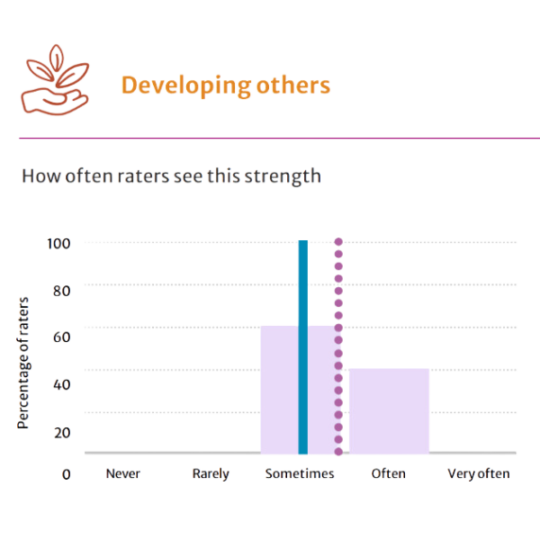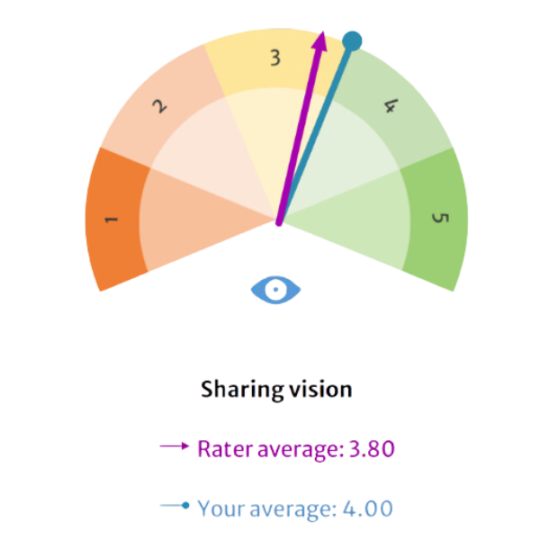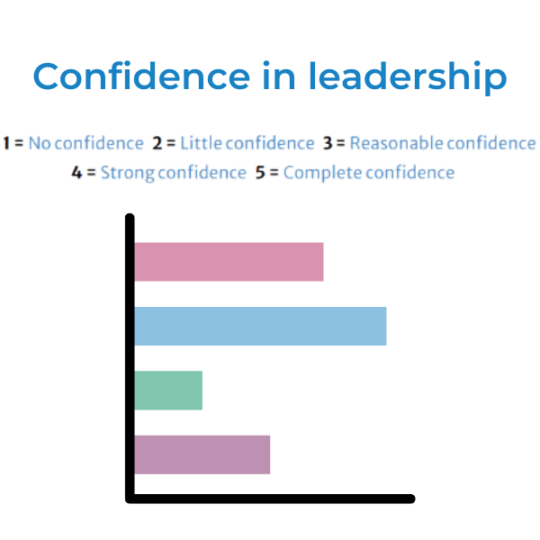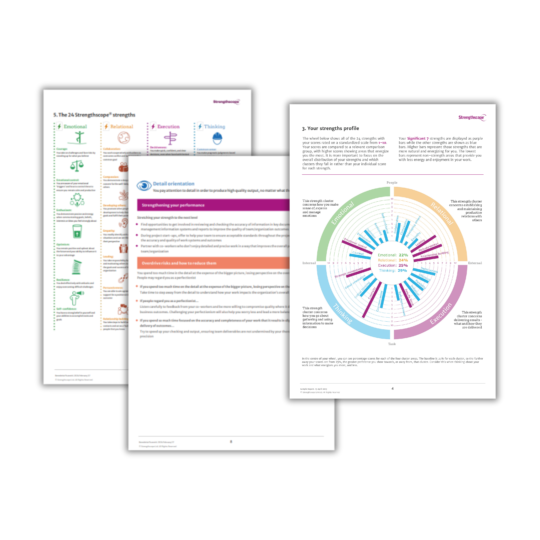
Achieving leadership goals with strengths
Authentic leaders achieve greater impact than those trying to fit a stereotype of a leader. The StrengthscopeLeader™ report helps leaders use their strengths to bring out their best leadership behaviour. It is the first strengths assessment in the market where the leader receives 360 feedback from up to 20 raters.
Based on our research into behaviour, preference, personality, and motivation, we measure 24 intrinsic qualities that are most closely related to work performance. We focus on increasing your understanding of your unique intrinsic qualities. The likelihood of you having the same Strengths Wheel as someone else is 1 in 1.3 billion.

Understand how your strengths show up at work and how effective you are in using your strengths to deliver results. Our report shows feedback ratings from up to 20 people.

The most effective leaders share 4 habits: sharing vision, sparking engagement, skillfully executing and sustaining progress. With our report, you can see how your raters have scored your effectiveness across the four leadership habits – and how it compares to your self-score.

To be a highly effective leader, you need to ensure you are delivering planned results and continuously improving the performance of your team. With our report, you can see how your raters have scored their level of confidence in you as a leader to deliver purpose, passion, process and performance.


Here at Strengthscope, we are helping clients like you to embed strengths into the full employee lifecycle.
The key application areas we support are:

We define strengths as ‘underlying qualities that energise you and that you are great at or have the potential to become great at’.
It’s built on a wide range of research in the fields of personality, ability, positive psychology and strengths. We drilled down to identify the essence of strengths at work; finally selecting 24 strengths which best captured performance-critical strengths in the workplace. These strengths are broken down into four ‘clusters’ of strengths, as follows:
• Emotional: these strengths relate to how you manage and express your emotions in relation to circumstances and people around you.
• Relational: these strengths relate to establishing and maintaining productive relations with others.
• Thinking: these strengths relate to the areas in which you prefer to apply your intellect, as well as how you go about gathering and using information to make decisions at work.
• Execution: these strengths relate to delivering results, in terms of content and delivery.
Yes, this is possible, but doesn’t occur very often. This is because we tend to build skill and competence in areas we are naturally more drawn to. However, a person might not have had the opportunity to develop skills and experience in an area of strength, meaning that it has remained an under-developed strength. Of course, this area offers lots of potential for development and learning for the person and could over time become a fully optimised strength.
The first question you need to ask is, “What is the impact of this non-strength/weaker area on my performance?” If there is little or no impact on your current work or future aspirations, then you probably shouldn’t invest too much time trying to develop in this area. However, if there is a negative impact on your performance or potential as a result of this area, or if there is the risk of such impact, you should consider ways to make your non-strength/weaker area less relevant by mitigating or improving it. Possible approaches include:
No, since management and leadership roles tend to vary significantly from organisation to organisation, there is no one set of strengths that make up a ‘good manager’. Also, research has found that similar managers and leaders call on vastly different strengths to undertake their role, with equally impactful outcomes. What is important to the success of a manager or leader is knowing one’s strengths and applying these as optimally as possible, whilst managing or minimising performance risks to make them less relevant.
Research has shown that an individual’s strengths tend to be fairly stable over time, as they are a core part of who we are as individuals. However, important life events (marriage, divorce, major job change, childbirth, etc.) may bring strengths into the foreground or push them into the background for a period of time.
Strengthscope® identifies the things that ‘strengthen’ or energise you – this is a critical distinction between Strengthscope® and a general personality measure, such as OPQ or Insights, for example. Strengthscope® does not describe behavioural preference (as personality questionnaires do) but instead identifies the behaviours and activities which make us feel strong, powerful and energised.
Strengthscope® differs in several important ways from other strengths assessments:
Competencies are typically defined as characteristics and behaviours that predict successful organisational outcomes. Most organisations using competencies have focused their efforts on defining skills, knowledge and behaviours associated with success in a particular role, function or at a particular level in the organisation (e.g. leadership). Unlike competencies, strengths are related to the person and not the role, function or level. They have a strong emotional element as well as leading to valued outcomes; the best signpost of a strength is when something energises or strengthens you. Strengths are also part of your character – things that are core to you and are fairly consistently expressed across situations. Unlike surface characteristics such as skills and knowledge, strengths are relatively ‘hardwired’ in our teens and are difficult to develop and fundamentally change beyond this point. We believe it is at the point where skills and knowledge (competencies) and energisers (or strengths) overlap, that productive habits can be developed, which lead to sustainable peak performance.
Strengthscope® is one of the very few assessments to have achieved registered-test status with the British Psychological Society, which represents the global gold standard for psychometric design. Strengthscope® is the only strengths assessment available globally to have achieved this standard. In practice, this means that it has been built with rigour and has a substantial amount of test data to support it.
The StrengthscopeLeader™ report is the only dedicated strengths-based 360 leadership profiler on the market today. It allows leaders to discover what makes them truly unique and provides valuable feedback on how to bring their authentic style into their leadership role.
The StrengthscopeLeader™ model is based on 3 key areas, which are critical for leadership effectiveness:
• What you bring to leadership – Your strengths
• How you lead or behave – Leadership habits
• Outcomes and success drivers.
StrengthscopeLeader™ contains similar information as the Strengthscope® and Strengthscope360™ profiles, as all three contain information on your strengths in the form of the ‘strengths wheel’ and also provide information on your Significant 7 Strengths. StrengthscopeLeader™, however, is a much more comprehensive profile and provides additional information about how well leaders are performing against 4 well-researched habits (or behaviours) every leader needs to be successful, as well as the outcomes they deliver. As with Strengthscope® and Strengthscope360™, feedback on the profile from a trained practitioner or coach is an important and required element for someone who has completed StrengthscopeLeader™, as this will allow the leader to gain the most value from their profile.
Not found the answer you’re looking for? Speak to our team!Bring in our expert facilitators to run workshops and deliver coaching for your teams.
We offer one-to-one or group coaching sessions, and strengths-based team interventions tailored to your needs.
Learn moreGet accredited to run your own Strengthscope® assessments, workshops and debriefs.
Our public accreditations are delivered live and virtually across 2-days. Our in-company accreditations are delivered in person or virtually.
Learn more